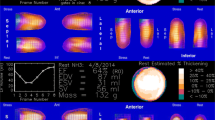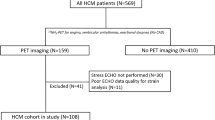Abstract
Background
Apparent left ventricular cavity dilatation (LVCD) in patients with hypertrophic cardiomyopathy (HCM) is an incompletely understood phenomenon. We aimed at investigating its clinical predictors and potential mechanisms.
Methods
Sixty one HCM patients underwent N-13-ammonia PET for visual evaluation of LVCD, transient ischemic dilatation (TID) index, myocardial blood flow (MBF), coronary flow reserve (CFR), and regional myocardial perfusion (rMP). TID index was also derived at 2–4 and 15–20 minutes.
Results
Visual LVCD and quantitative TID (>1.13 abnormal) agreement were excellent (k 0.91; P < .0001). LVCD-positive (n = 32) patients had greater LV thickness (2.26 ± 0.59 vs 1.92 ± 0.41 cm; P = .005), but lower stress MBF (1.66 ± 0.42 vs 2.07 ± 0.46 mL/minute/g; P < .0001), and CFR (1.90 ± 0.46 vs 2.46 ± 0.69; P < .0001) than LVCD-negative (n = 29) patients. Abnormal rMP was present in 31/32 LVCD-positive but only 12/29 (P < .0001) LVCD-negative. TID index was higher at 2–4 (1.30 ± 0.13) than at 15–20 minutes (1.27 ± 0.12; P = .001) in LVCD-positive, whereas it was the same (1.04 ± 0.07 vs 1.04 ± 0.07; P = .9) in LVCD-negative. In multivariate analysis, global peak MBF, abnormal rMP, and LV thickness were the best predictors of LVCD.
Conclusion
Apparent LVCD is a common finding in HCM, intimately related to abnormal myocardial perfusion, globally impaired vasodilator flow reserve, and degree of hypertrophy. In addition to regional and/or diffuse subendocardial ischemia, some degree of true LV chamber dilatation may also contribute to the occurrence of apparent LVCD in HCM.






Similar content being viewed by others
Abbreviations
- HCM:
-
Hypertrophic cardiomyopathy
- LVCD:
-
Left ventricular cavity dilatation
- MBF:
-
Myocardial blood flow
- CFR:
-
Coronary flow reserve
- TID:
-
Transient ischemic dilatation
- PM:
-
Papillary muscles
References
Bravo PE, Pinheiro A, Higuchi T, Rischpler C, Merrill J, Santaularia-Tomas M, et al. PET/CT assessment of symptomatic individuals with obstructive and nonobstructive hypertrophic cardiomyopathy. J Nucl Med 2012;53:407-14.
Weiss AT, Berman DS, Lew AS, Nielsen J, Potkin B, Swan HJ, et al. Transient ischemic dilation of the left ventricle on stress thallium-201 scintigraphy: A marker of severe and extensive coronary artery disease. J Am Coll Cardiol 1987;9:752-9.
Iskandrian AS, Heo J, Nguyen T, Lyons E, Paugh E. Left ventricular dilatation and pulmonary thallium uptake after single-photon emission computer tomography using thallium-201 during adenosine-induced coronary hyperemia. Am J Cardiol 1990;66:807-11.
Rischpler C, Higuchi T, Fukushima K, Javadi MS, Merrill J, Nekolla SG, et al. Transient ischemic dilation ratio in 82Rb PET myocardial perfusion imaging: Normal values and significance as a diagnostic and prognostic marker. J Nucl Med 2012;53:723-30.
Gersh BJ, Maron BJ, Bonow RO, Dearani JA, Fifer MA, Link MS, et al. 2011 ACCF/AHA guideline for the diagnosis and treatment of hypertrophic cardiomyopathy: Executive summary: A report of the American College of Cardiology Foundation/American Heart Association Task Force on Practice Guidelines. Circulation 2011;124:2761-96.
Lang RM, Bierig M, Devereux RB, Flachskampf FA, Foster E, Pellikka PA, et al. Recommendations for chamber quantification: a report from the American Society of Echocardiography’s Guidelines and Standards Committee and the Chamber Quantification Writing Group, developed in conjunction with the European Association of Echocardiography, a branch of the European Society of Cardiology. J Am Soc Echocardiogr 2005;18:1440-63.
Bravo PE, Pozios I, Pinheiro A, Merrill J, Tsui BM, Wahl RL, et al. Comparison and effectiveness of regadenoson versus dipyridamole on stress electrocardiographic changes during positron emission tomography evaluation of patients with hypertrophic cardiomyopathy. Am J Cardiol 2012;110:1033-9.
Rajaram M, Tahari AK, Lee AH, Lodge MA, Tsui B, Nekolla S, et al. Cardiac PET/CT misregistration causes significant changes in estimated myocardial blood flow. J Nucl Med 2013;54:50-4.
Hutchins GD, Schwaiger M, Rosenspire KC, Krivokapich J, Schelbert H, Kuhl DE. Noninvasive quantification of regional blood flow in the human heart using N-13 ammonia and dynamic positron emission tomographic imaging. J Am Coll Cardiol 1990;15:1032-42.
Bangalore S, Yao SS, Chaudhry FA. Role of angiographic coronary artery collaterals in transient ischemic left ventricular cavity dilatation during stress echocardiography. Clin Cardiol 2006;29:305-10.
Abidov A, Bax JJ, Hayes SW, Hachamovitch R, Cohen I, Gerlach J, et al. Transient ischemic dilation ratio of the left ventricle is a significant predictor of future cardiac events in patients with otherwise normal myocardial perfusion SPECT. J Am Coll Cardiol 2003;42:1818-25.
Emmett L, Magee M, Freedman SB, Van der Wall H, Bush V, Trieu J, et al. The role of left ventricular hypertrophy and diabetes in the presence of transient ischemic dilation of the left ventricle on myocardial perfusion SPECT images. J Nucl Med 2005;46:1596-601.
Robinson VJ, Corley JH, Marks DS, Eberhardt LW, Eubig C, Burke GJ, et al. Causes of transient dilatation of the left ventricle during myocardial perfusion imaging. Am J Roentgenol 2000;174:1349-52.
Sugihara H, Shiga K, Umamoto I, Harada Y, Katahira T, Nakagawa T, et al. Assessment of transient dilation of the left ventricular cavity in patients with hypertrophic cardiomyopathy by exercise thallium-201 scintigraphy. Kaku Igaku 1990;27:1281-9.
Cannon RO 3rd, Dilsizian V, O’Gara PT, Udelson JE, Schenke WH, Quyyumi A, et al. Myocardial metabolic, hemodynamic, and electrocardiographic significance of reversible thallium-201 abnormalities in hypertrophic cardiomyopathy. Circulation 1991;83:1660-7.
Tanaka M, Fujiwara H, Onodera T, Wu DJ, Matsuda M, Hamashima Y, et al. Quantitative analysis of narrowings of intramyocardial small arteries in normal hearts, hypertensive hearts, and hearts with hypertrophic cardiomyopathy. Circulation 1987;75:1130-9.
Maron BJ, Wolfson JK, Epstein SE, Roberts WC. Intramural (“small vessel”) coronary artery disease in hypertrophic cardiomyopathy. J Am Coll Cardiol 1986;8:545-57.
Krams R, Kofflard MJ, Duncker DJ, Von Birgelen C, Carlier S, Kliffen M, et al. Decreased coronary flow reserve in hypertrophic cardiomyopathy is related to remodeling of the coronary microcirculation. Circulation 1998;97:230-3.
Harrigan CJ, Appelbaum E, Maron BJ, Buros JL, Gibson CM, Lesser JR, et al. Significance of papillary muscle abnormalities identified by cardiovascular magnetic resonance in hypertrophic cardiomyopathy. Am J Cardiol 2008;101:668-73.
Han Y, Osborn EA, Maron MS, Manning WJ, Yeon SB. Impact of papillary and trabecular muscles on quantitative analyses of cardiac function in hypertrophic cardiomyopathy. J Magn Reson Imaging 2009;30:1197-202.
Janik M, Cham MD, Ross MI, Wang Y, Codella N, Min JK, et al. Effects of papillary muscles and trabeculae on left ventricular quantification: Increased impact of methodological variability in patients with left ventricular hypertrophy. J Hypertens 2008;26:1677-85.
Brazier JR, Maloney JV Jr, Buckberg GD. Papillary muscle ischemia with patent coronary arteries. Surgery 1975;78:430-7.
Waters BL. Clinical and pathologic factors contributing to acute papillary muscle ischemia. Arch Pathol Lab Med 1990;114:601-4.
Brand FR, Brown AL Jr, Berge KG. Histology of papillary muscles of the left ventricle in myocardial infarction. Am Heart J 1969;77:26-32.
Coma-Canella I, Gamallo C, Onsurbe PM, Jadraque LM. Anatomic findings in acute papillary muscle necrosis. Am Heart J 1989;118:1188-92.
De Busk RF, Harrison DC. The clinical spectrum of papillary-muscle disease. New Engl J Med 1969;281:1458-67.
Van Tosh A, Hecht S, Berger M, Roberti R, Luna E, Horowitz SF. Exercise echocardiographic correlates of transient dilatation of the left ventricular cavity on exercise thallium-201 SPECT imaging. Chest 1994;106:1725-9.
Disclosure
The authors declare that they have no conflict of interest.
Author information
Authors and Affiliations
Corresponding author
Additional information
See related editorial, doi:10.1007/s12350-015-0180-x.
Rights and permissions
About this article
Cite this article
Bravo, P.E., Tahari, A., Pozios, I. et al. Apparent left ventricular cavity dilatation during PET/CT in hypertrophic cardiomyopathy: Clinical predictors and potential mechanisms. J. Nucl. Cardiol. 23, 1304–1314 (2016). https://doi.org/10.1007/s12350-015-0158-8
Received:
Accepted:
Published:
Issue Date:
DOI: https://doi.org/10.1007/s12350-015-0158-8




